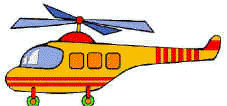BACKGROUND:
Understanding physics is actually a
two fold educational process. In addition to developing an accurate
conceptual background, students need to apply concepts to solve
problems. It is important for children to learn the concepts before they
can even understand why they are solving mathematical problems.
The focus of the student is operational, trying to find the mathematical
definition that will solve the problem. If a child learns the major
concepts first, each problem a child encounters will have a point to
start solving the problem. That student becomes an expert problem
solver.
Toys can help a child start their
problem solving adventure. Toys are created to entertain. The
entertainment factor is there because toys usually do something that is
"odd." A child will tend to play with a toy longer, if they
are trying to figure out what is going on. Even after they figure the
physics behind it, it still will maintain the entertainment value
because the child then feels like they really understand the toy.
Common toys like magnets and toys that light up due to
electricity, keep students wondering how they
work. Just creating a rainbow from a piece of clear glass plastic (prism) has
magical properties. Gliders that soar through the air because they can
"capture" air molecules is really an awesome idea.
Toys like the hand boiler or "love meter" operate on
the force of air pressure. The hand boiler appears to "boil"
making the person reason that they are "hot." The heat of the
hand on the hand boiler changes the pressure in the glass chamber,
pushing the liquid upward.
Toys like "the alien ball or
energy ball" has two batteries inside, a circuit, bulb, and sound
system. When you hold the ball the electrons flow from the battery and
use your body as a wire. The ball lights up when you touch it.
Accurately you are completing the circuit.
Almost a century ago, Jacob's Ladder was a novel toy parents bought to amuse their children. The toy is made
of wooden blocks and cotton tape in such a way it gives the illusion of
the wood blocks tumbling over each other and down the
"ladder." The toy is also know as "clacker blocks"
because of the rhythmic slapping sound the blocks makes while falling.
The original name comes from the Bible where Jacob dreams of a ladder
stretching down from heaven to Earth on which angels make their way up
or down. Actually the design of Jacob's ladder takes into account
friction and gravity. Without the exact placement of the cloth and
without gravity pulling it down to earth, it would not work.
PROCEDURE:
-
Read The Crazy Toy Scientist to students. This
poem looks at a scientist that needs to understand older toys and
try to create a toy that children will buy. Notice that the
toy market expanded after World War II, and most of the toys that we
see today are from that era. Today simulated computer games
have added another dimension to the toy market.
-
Toys are a perfect
example of physics used for
 pure enjoyment. In this exercise, students go to the different toy
stations and record what they think the "physics factor" may
be. Instruct students to choose from the following words: magnetism,
motion, force, sound, electricity, light, and matter. (You can add more
factors or change others). The lab allows students to begin developing
reasons why certain phenomena occur. Students will not understand all
the components of the toys, but they will start to associate words.
Students do not yet have the background to "understand" what
is happening. The important lesson is to recognize that physics can
describe how toys work. This lab tries to familiarize students with the
science of physics, not to explain all the different parts.
pure enjoyment. In this exercise, students go to the different toy
stations and record what they think the "physics factor" may
be. Instruct students to choose from the following words: magnetism,
motion, force, sound, electricity, light, and matter. (You can add more
factors or change others). The lab allows students to begin developing
reasons why certain phenomena occur. Students will not understand all
the components of the toys, but they will start to associate words.
Students do not yet have the background to "understand" what
is happening. The important lesson is to recognize that physics can
describe how toys work. This lab tries to familiarize students with the
science of physics, not to explain all the different parts.
-
Each toy should be
a separate station. Instruct the students to go from one station to the
next after about 2-4 minutes. The more stations you have the less time
you can allow for children to play. Play is important. Instruct students
to "think" about how the toy is doing its trick.
-
Some of these toys
have more than one principle in operation, however the point of this lab
is to get the students familiar with the term PHYSICS. If the students
can justify why they labeled the toy a certain way, and the logic is
justified, accept the answer. You may want to add different types of
toys to create more stations.
-
The following are
toys that fit the above scheme:
(1) magnetism - magnetic marbles, space wheel.
(2) motion - ball, glider, timer.
(3) force - hand boiler,
glider, Jacob's ladder.
(4) sound - energy ball.
(5) electricity -
energy ball; (6) light - energy ball, prism.
(7) matter - all of the
toys are solids, the students can call the hand boiler liquid.
|